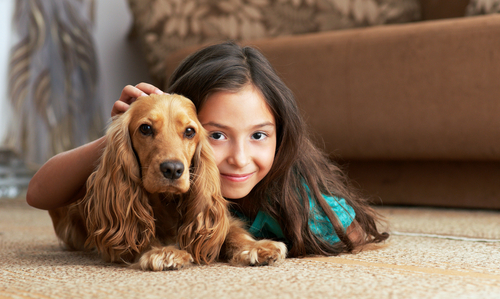
Photo: Shutterstock
If you are considering getting a dog or have one at home, but you or someone in your family find yourself sneezing, stuffy-nosed or getting a rash when you are near this four-footed family member, you very likely allergic to dogs. Most people mistakenly believe that it is the hair shed by dogs or certain breeds that cause the allergy. In fact, fur and breeds have very little to do with it.
Pet allergies occur when people develop an immune system reaction to particular proteins, the large biological molecules that all living things produce. The human body reacts by sending antibodies to the area where the protein is entering the body, which is usually the nose and nasal passages, and this causes the allergy symptoms. If the protein enters the lungs, the body’s reaction there can lead to asthma.
In dogs, the troublesome protein can be found in its skin cells, saliva and urine. When skin cells die and flake off, the tiny particles, called dander, can get in the air, as well as land and accumulate on on the floor, in bedding, curtains and the cloth of sofas and chairs. When a dog licks its fur, the protein gets transferred onto the hair and can then become airborne when the fur dries. This airborne protein can lead to allergic reactions in people even days after the pet is removed.
There are several ways to deal with being allergic to dogs and reduce the severity of the problem, without sending the dog away. On the other hand, if the dog is causing severe asthma or breathing problems, then it is important to get the person away from the dog immediately and then consider how to proceed.
- One effective way to remove dander is by using an air purifier that is designed specifically to trap it, such as filters that are labeled HEPA (High Efficiency Particulate Air). While shopping around for one, don’t forget to mention to the sales clerk that you need this feature and ask whether you’d need more than one device with regards to the size of your home.
- Regular bathing of the dog at least weekly ensures that excess dander is washed away. The dog’s bedding and toys should also be washed once a week.
- Brush the hair of your dog daily, either outdoors or in a well-ventilated area. Brushing removes loosened hair and can thus help get rid of some dander. Keeping the hair groomed and short may also help.
- Strictly keep your dog out of the bedroom and off bedding. This ensures that everyone in the household can get a good night’s rest.
- Dust and damp-clean the house everyday to stop dander from accumulating around problem areas such as curtains, carpets and upholstery. Be sure to open the windows regularly to air out your house. Without proper ventilation, the likelihood of dander build-up is far greater.
- Practice personal hygiene by way of regular hand washing after playing with your dog and avoid touching your face or eyes until you do.
- Do not allow your to lick your face
There are also medical treatments that may help with the allergy, such as antihistamines and decongestants for short-term relief, and inhalers for long-term asthma control and immunotherapy for long-term treatment to reduce allergic reactions. While some of these medicines are allowed to be sold without a prescription, it is always a good idea to consult a qualified physician and determine the best treatment for you or your child.
Were you able to overcome your allergies and keep a dog? Share your experience below. Please like FamiLife’s page on Facebook so that you get all our articles and others may find us.
